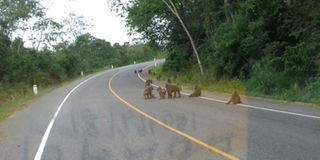4,000 hectares of forest cover restored- UWA

Restored. Part of the restored Kibale National Park. PHOTO BY FELIX BASIIME
What you need to know:
Measures. Authorities have constructed pillars and planted trees on boundaries to limit human activities in the national park
KAMWENGE. In a bid to boost biodiversity and tourism in the Rwenzori sub-region, Uganda Wildlife Authority (UWA) has embarked on forests restoration.
In Kibale conservation area, 4,000 out of 10,000 hectares of forest have been restored in Kamwenge District, according to the chief warden of the conservation area, Mr Nelson Guma.
The project that started in 1995 has also seen 2,500 hectares regenerated naturally.
Kibale conservation area covers 766 square kilometres in parts of Kamwenge, Kabarole and Kyenjojo districts.
According to Mr Guma, the restorations will help combat climate change and restore biodiversity.
Kibale conservation area is well known for hosting primates in the whole world with about 13 species. Mr Guma said, the project will also provide habitat for biodiversity.
“So far, the number of elephants has increased as well as chimps and we hope in the near future we shall have plenty of them and more tourists will come,” he said.
With the initiative, Mr Guma said new tree species have increased too. He, however, noted that with increase in biodiversity ,human-wildlife conflict will also increase.
Activities
In a bid to stop wild animals from invading communities, Mr Guma revealed that they have dug trenches to block them from crossing. They have also empowered communities to set up beehives.
Authorities have also constructed pillars and planted trees on boundaries to limit human activities in the park.
In Bundibugyo District, the Resident District Commissioner, Ms Grace Kakwenza, has appealed to the communities to stop destroying the forests .
“We are now experiencing good weather because of the restored forests and once destroyed, the weather pattern will change,” she said:
The Bundibugyo District chairman, Mr Godfrey Mutegeki, has encouraged communities to promote tourism by popularising Semuliki National Park. “It’s a shame to find that people from other places know what is in Semuliki but the local communities do not know,” he said.
Decline
The State Minister for Environment, Ms Mary Goretti Kitutu, last year said Uganda’s forest cover has been depleted to eight per cent up from 24 per cent in the 1990s, which she attributed to human encroachment. A 2018 report on Uganda’s forest cover rby the Advocates Coalition for Development and Environment (Acode) also indicates that the country’s total forest cover reduced by 27 per cent between 1990 and 2005 and in that period, , total coverage reduced from 4.9 million hectares to 1.8 million hectares.




